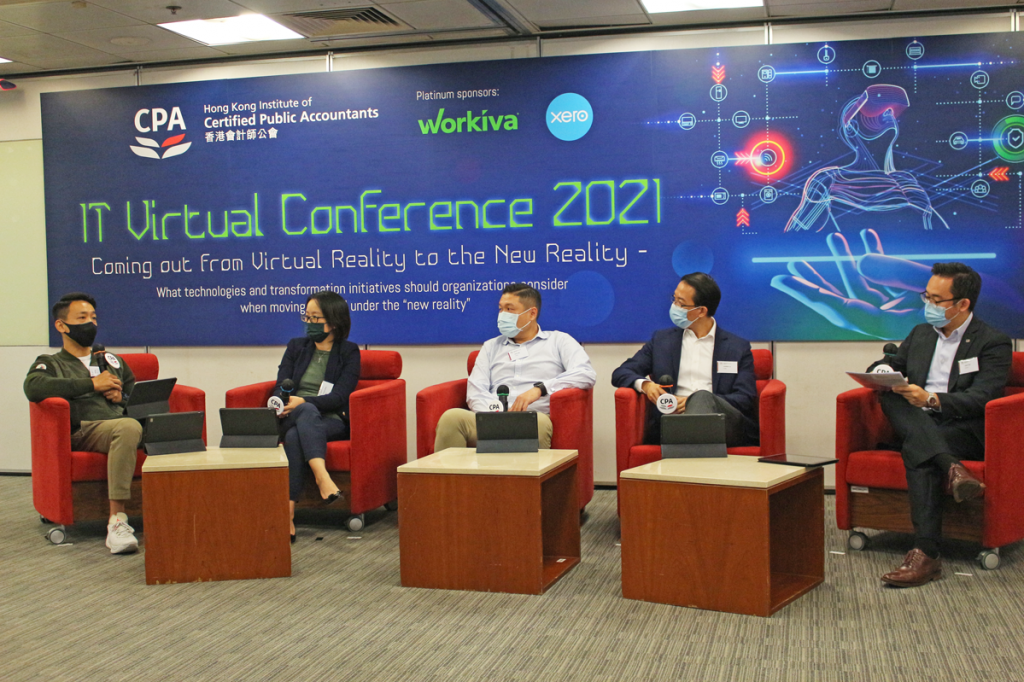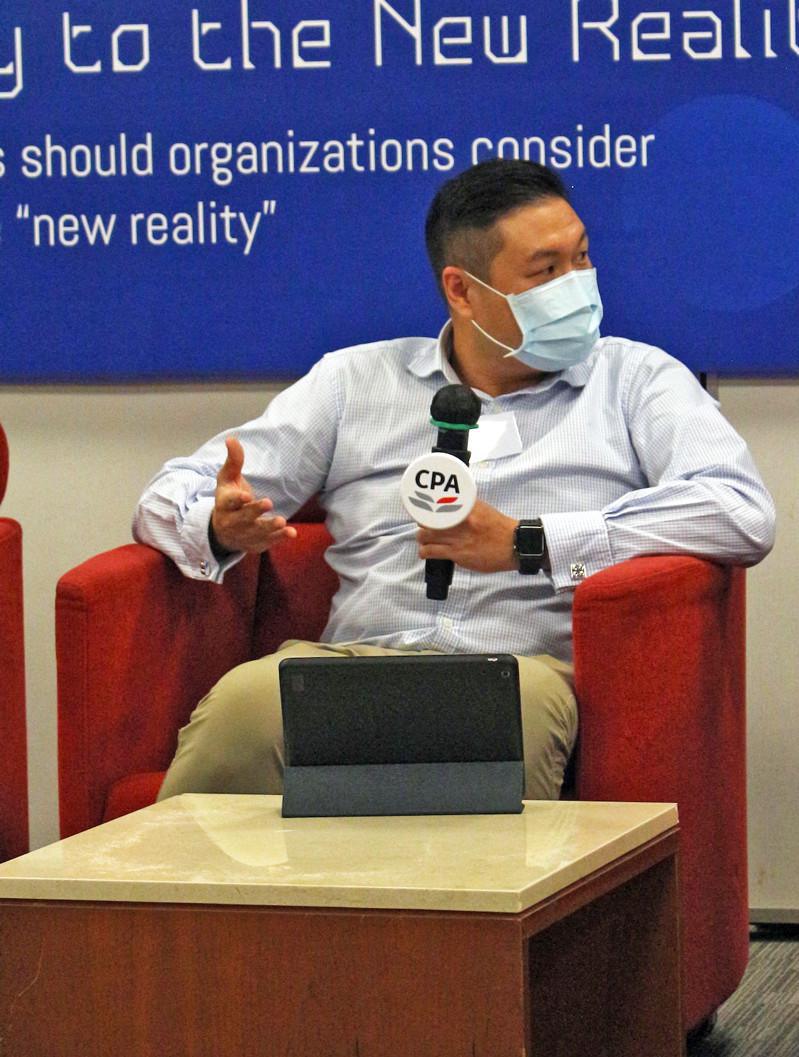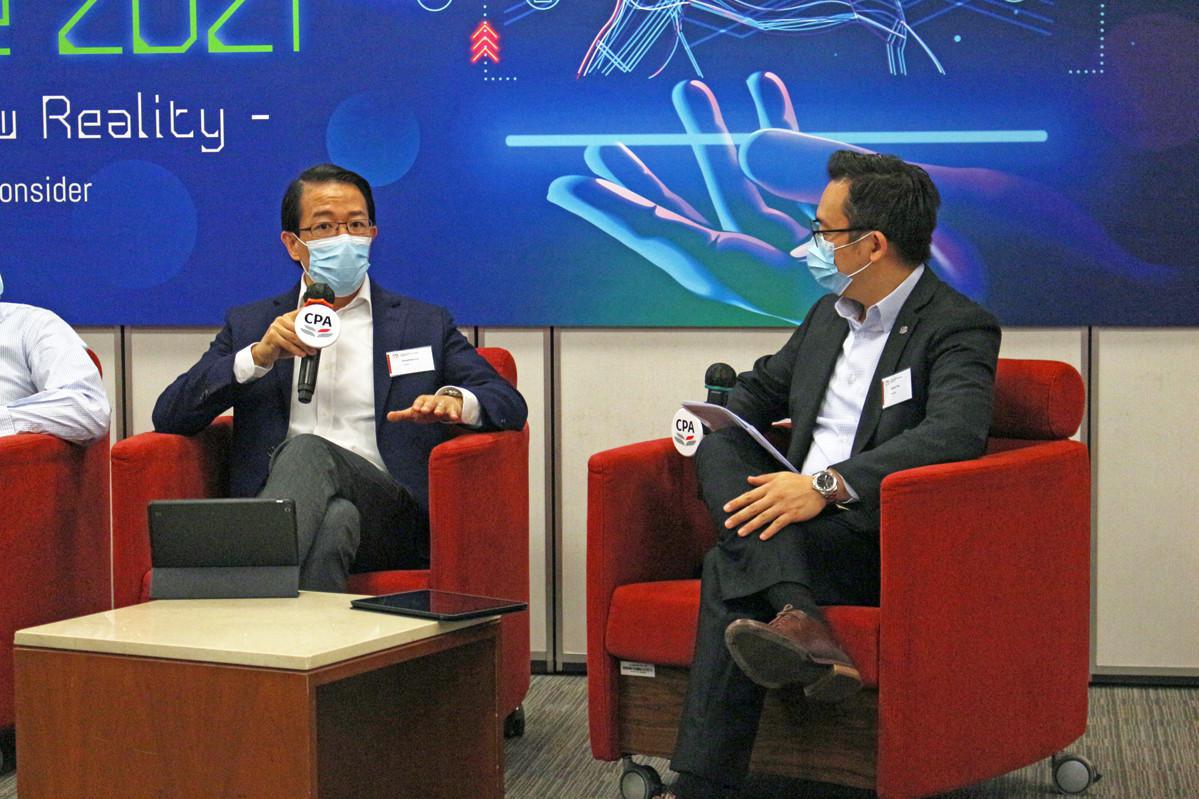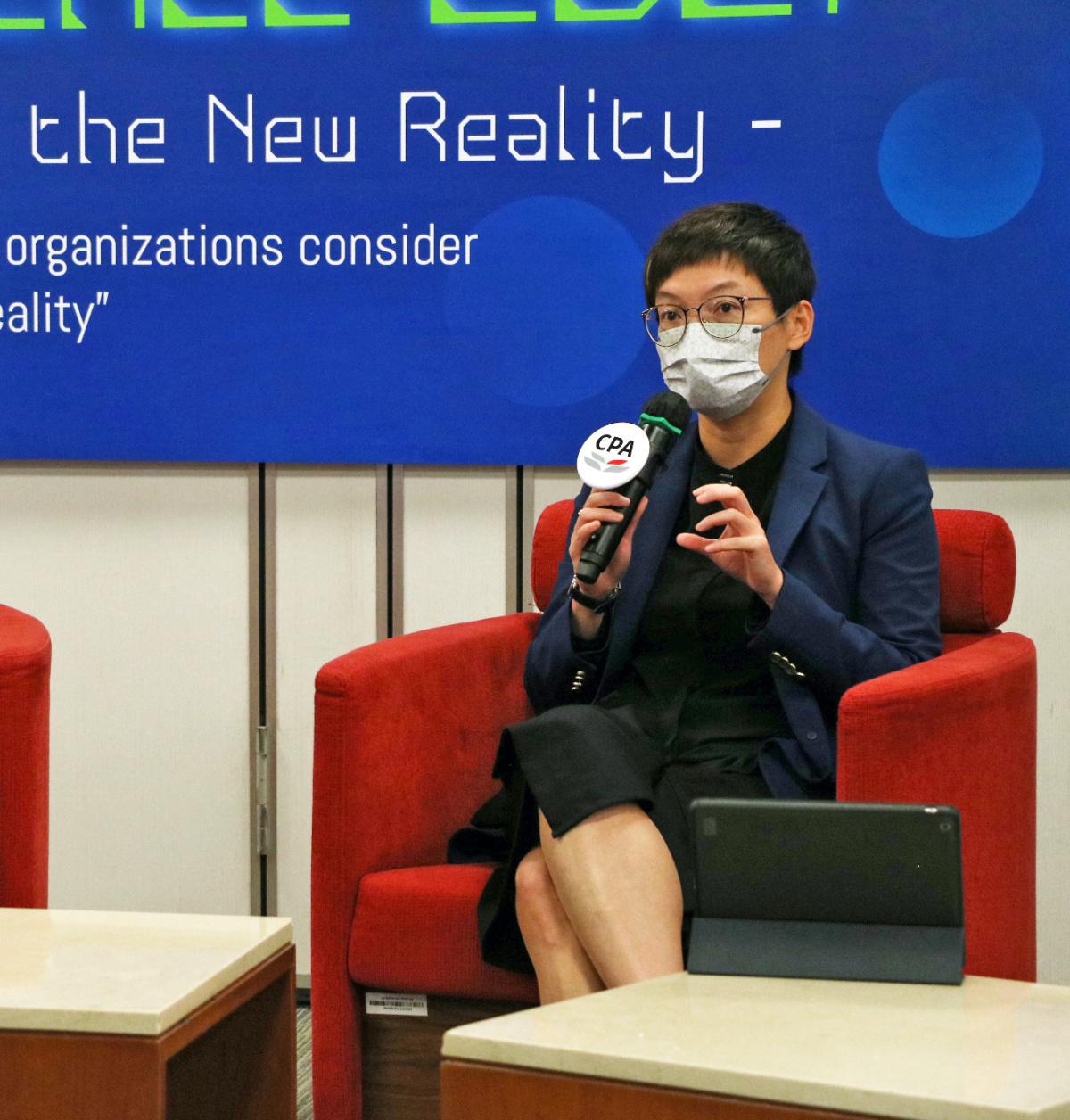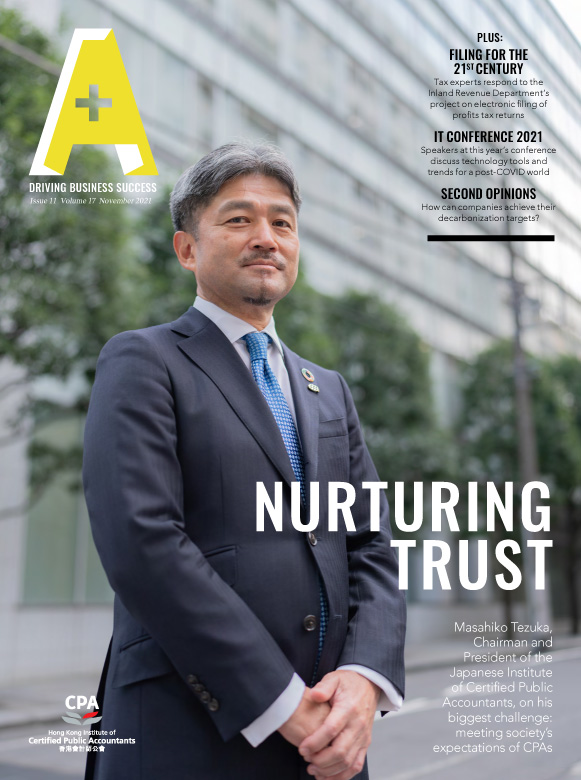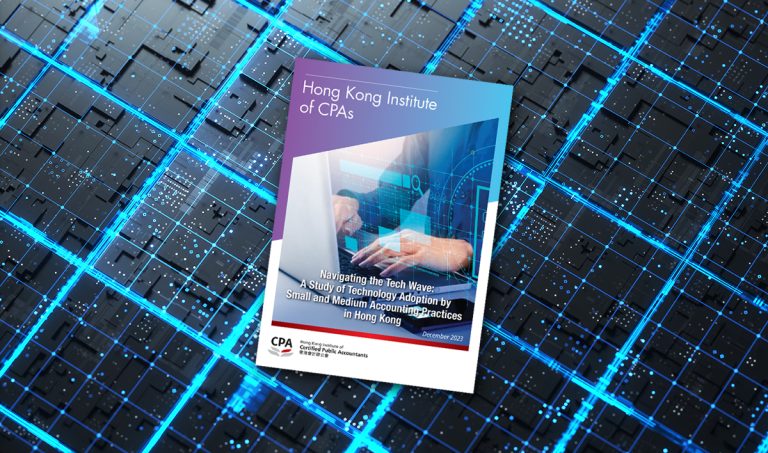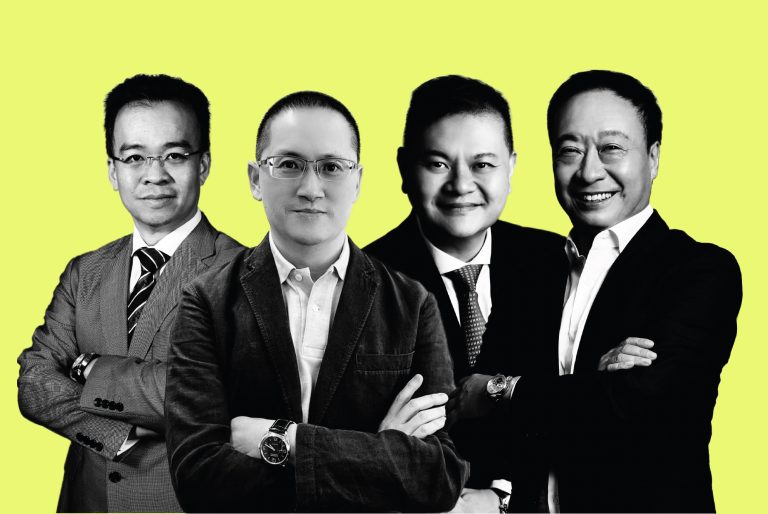In the next decade, the economic performance of every business will be defined by the speed of their digital transformation over the next few quarters, according to Vyin Ng, Chief Financial Officer of Microsoft Hong Kong and Macau. The COVID-19 pandemic has accelerated the pace of digital change, with two years’ worth of transformation happening in the space of just a couple of months, she told the Hong Kong Institute of CPAs’ IT Virtual Conference 2021 held in October and themed “Coming out from Virtual Reality to the New Reality.”
“The trend we are seeing in the market is that customers are very proactive about exploring how to digitally transform their business, not just their normal operations, but how to grow bigger and faster, to keep pace with the market,” she said.
(From left) Willy Wong, Partner – Technology Consulting at EY Mtel; Sammie Shum, Partner at Deloitte Consulting and Future of Work Leader; Aaron Ma, Partner at PwC Mainland China and Hong Kong; Jonathan Lo, Partner, HR Transformation Lead and Lead HR Target Operating Model Architect at KPMG China; and Jason Yau CPA, Partner, Technology and Management Consulting at RSM Hong Kong.
Ng pointed out that data is now abundant, and businesses rely on finance professionals to provide reports and insights based on this data. But she added that legacy systems in most companies have lagged the pace of data growth, while mergers and acquisitions have led to systems across large corporations being disconnected, and many systems offer only a static view and are not interactive. “If the tools do not change, finance becomes involved in data reconciliation as a manual process that is very inefficient and creates a lot of errors,” she said.
Vyin Ng, Chief Financial Officer of Microsoft Hong Kong and Macau.
In a keynote address, “Modernization of finance in the new normal,” Ng said the first stage of digital transformation is for companies to enable remote work, including helping teams to collaborate virtually and share files and data in a secure way. The next stage involves optimizing processes by reducing those that do not add value, and managing risk. A key part of this stage is setting up a common data platform. The final stage of digital transformation involves reimagining work, using artificial intelligence (AI) to gain insights from data, machine learning for forecasting and automating routine tasks such as bookkeeping and invoicing to ensure accuracy and enabling these tasks to be conducted at scale around the clock.
Creating a common data platform is a key part of the process, Ng told the conference. She explained: “At Microsoft, we have a common data platform that connects all the revenue scorecards and key performance indicator metrics, historical information and future pipelines. It can be seen by all employees with their role-based security access.” For example, a regional sales director could go to the platform and see dashboards on their territory, while someone in the global corporate office could see worldwide data, she said.
“We in finance can transform ourselves by deprioritizing manual activities and elevating ourselves into business partners who drive impact and influence.”
AI is then used to extract critical information from the data, to provide insights to inform business decisions, while machine learning is employed to forecast what may happen in the future. “When teams go into business reviews, they need to prepare different scenarios. Our database helps us come up with interactive dashboards and data by geography and products, overall business performance and budget attainment. There is more granularity because data has been structured in a way that allows these ‘drill down functions,’” she said.
Ng explained that the combination of the data and machine learning enables the finance team to predict future revenue performance of different areas of the business, helping management to allocate resources in a way that best supports business growth. “With all of this digital transformation, we in finance can transform ourselves by deprioritizing manual activities and elevating ourselves into business partners who drive impact and influence.”
Transforming the workforce
The pandemic has not only accelerated digital transformation, but it has also changed both client and employee expectations, according to a panel discussion session on “Innovative trends and best practices on the future of work.”
Jason Yau CPA, Partner, Technology and Management Consulting at RSM Hong Kong, who was moderating the panel, said: “Clients are expecting us to leverage on the power of technology to provide services more effectively and efficiently, and employees are expecting us to provide more flexibility and understanding, and to help them reskill.”
Ng described remote working as being the first stage of digital transformation, and Sammie Shum, Partner at Deloitte Consulting and Future of Work Leader, commented that Deloitte had already started to shift to virtual working before the COVID-19 pandemic. “We wanted to reinforce a culture of trust and empowerment in response to the new generation in the workforce who want more flexibility and autonomy.” To ensure a successful transition the firm invested not just in infrastructure, but also in helping to change the mindset and capabilities of everyone across the organization. To help both clients and employees make the transition, Shum said it is very important to model best practice during virtual meetings, and ensure that clients have good visibility on projects. She explained that this is necessary, as while some clients expect remote working to lead to a productivity gain, others are concerned it will be less effective.
Jonathan Lo, Partner, HR Transformation Lead and Lead HR Target Operating Model Architect at KPMG China, agrees that employees need training to adjust to virtual working: “No one is naturally used to working completely virtually. We try to teach them virtual etiquette, such as the way you greet people, or run a meeting. We need to lead by example,” he said. Aaron Ma, Partner at PwC Mainland China and Hong Kong, added that PwC has offered similar training, looking at both hard skills in terms of how to use the technology, but also soft skills, such as conducting an effective virtual meeting. Going forward, the panel expect a hybrid model of working to become the norm, creating a new set of challenges. Yau added: “The future of work will not be one way or another, it will be hybrid. We need to adapt to different people’s needs, such as those of employees, clients and managers.”
Aaron Ma, Partner at PwC Mainland China and Hong Kong.
(From left) Jonathan Lo, Partner, HR Transformation Lead and Lead HR Target Operating Model Architect at KPMG China; Jason Yau CPA, Partner, Technology and Management Consulting at RSM Hong Kong.
Willy Wong, Partner – Technology Consulting at EY Mtel.
Sammie Shum, Partner at Deloitte Consulting and Future of Work Leader.
Willy Wong, Partner – Technology Consulting at EY Mtel, pointed out that under this new model of work, employees will need better digital tools to enable them to mix on-site and remote work. He said EY’s office in Quarry Bay uses digital tools to help enhance productivity but also maintain social distancing when necessary. “We have adopted hot-desking; even partners don’t have their own room, and there are open areas for collaboration. We have installed more than 3,000 sensors so employees can use an app to see the occupancy rates of each floor. We have sensors to measure humidity, CO2 and temperature,” he said. “We also collect data on the employee experience and behaviour to see how we can improve the experience for them, as well as monitoring efficiency and productivity,” he said.
Wong pointed out that as more work takes place remotely, it is important not to lose sight of the importance of helping staff achieve a work-life balance. “Technology can be too efficient. Clients expect you 24/7. Even if there is a typhoon, you might still have 10 meetings. We need to build tools to monitor well-being and work-life balance.” Ma added that while some people will prefer to work from home, others will prefer to work on-site. “From a management perspective, there are three angles – people, processes and tools. We have to help employees maximize their working effort, empower them with the right tools, and have a fair process policy for all employees.”
Shum noted that going forward, virtual working also raises questions about talent retention. “It means we can source talent from outside of Hong Kong, but Hong Kong talent can also apply for jobs elsewhere. It raises questions about how you manage people across different locations and time zones, how you manage compensation, and how you translate it into a business model,” she said.
For small and medium practices that want to digitally transform, the panel suggest having the right mindset is as important as having the right tools. Yau added that trust is also key. “It can’t just be the group pushing for digital transformation; the employees also need to have this digital mindset,” he said. “There are a lot of tools out there that are reasonably priced and easy to implement. So, having the courage to make that first step and using a digital mindset to move forward is very important for smaller firms.”
Shum suggested taking a gradual approach, such as starting with certain elements or job functions that are easy to perform virtually and building from there. Lo added: “Millennials have a lot of ideas. Let them have some options; let them pilot something small. It gives them a lot of ownership and momentum.”
Overall, Wong thinks people, rather than technology, are the most important aspect of making virtual working effective. “People are the key asset in a company to create long-term value. We need to put people at the centre. Listen to their feedback, understand their pain points and create a better experience for them.”
Dr Crystal Fok, Head of STP Platform, Hong Kong Science and Technology Parks Corporation.
Supporting innovation
For firms interested in implementing new technology, the conference heard that Hong Kong Science and Technology Parks Corporation (HKSTP) has a new Technology Validation Platform to help them. “We would like to become your technology partner throughout your technology adoption journey,” Dr Crystal Fok, Head of STP Platform, HKSTP, said in her keynote address, “Technology Validation Platform: Invisible to visible.”
She explained that the typical technology adoption journey consists of three stages, namely the exploration stage, the proof of concept stage, and the deployment stage. The Technology Validation Platform can help companies at each of these stages. Fok said one of the issues companies face during the exploration stage is finding the right solution for their problem, as there are likely to be many technology providers in the market. “If you give us your problem statement, we can help you by setting up a technology challenge and through this, you will know what is available in the market,” she explained.
“Technology validation helps you to choose the most suitable vendor for your project.”
The next stage of the process is the proof of concept stage, during which HKSTP can help identify a good vendor through hosting a tender assessment or feasibility study. “This stage requires data, so we can set up a virtual environment with data in which vendors can test their algorithms, and fine tune them to improve the accuracy. We create a virtual environment to turn an AI solution from being invisible to visible,” she explained.
Fok gave the example of proof of concept run for the Electrical and Mechanical Services Department, which wanted to digitize investigation reports written by contractors about the elevators it manages. HKSTP set up a virtual environment in which vendors were given samples of these documents, both typed in English and handwritten in Chinese, on which to test their optical character recognition technology.
Vendors were able to identify the words in the typed reports with an accuracy of up to 91 percent, but for the written ones the accuracy was only around 65 percent. “They achieved this with only a small amount of data, but they think if they had more data, they could train the AI model and achieve accuracy of 80 percent or higher,” Fok said. Finally, the platform can help organizations at the deployment stage by assisting them in the final selection of the vendor.
Fok explained to the audience that HKSTP performed a validation exercise for the Food and Environmental Hygiene Department using image recognition software to count rodents. One vendor was able to count them with 94.8 percent accuracy, the other one with 91.1 percent accuracy. Although the second vendor had a slightly lower level of accuracy, the cost was half the price of the first one. “Technology validation helps you to choose the most suitable vendor for your project,” she said.
Fok added that the platform uses federated learning technology, a machine learning technique that builds algorithms using decentralized data pools. “The accounting world involves a lot of data, and in the past if you wanted to train AI, you needed to bring that data to a central system. But with federated learning technology, you don’t need to upload the data to a platform; you allow the AI algorithm to go to your data. When the task is complete it takes the insights with it but not the data,” Fok explained. She added that this approach helps to change the mindset around data sharing and create more comprehensive AI models.
Eric Yeung, Chief Executive Officer and Co-founder of Skyzer VC Group.
Playing virtual games
The conference also heard that it is not only work that is likely to be increasingly carried out virtually in future, but also sports. Eric Yeung, Chief Executive Officer and Co-founder of Skyzer VC Group, described the current trend as being e-sports 2.0 in his keynote address, “Virtual sports vs. traditional sports.” He explained that traditional sports are turned into electronic games through using virtual reality (VR) and simulation technology to emulate real-life sport, including the amount of effort the participant needs to put in. He gave the example of someone playing virtual golf using a real golf club and golf ball, but hitting it into a screen. “It is one of the hottest topics in the world right now. We believe it is the future of sport,” he said.
Yeung is predicting double-digit annual growth in e-sports in the coming years. He explained that this growth is being driven by a combination of VR devices becoming cheaper, and sensors becoming more accurate, meaning VR technology can be used in competitions.
“VR technology will not only change the gaming industry, but will rock the traditional sports industry as well.”
He added that the take up pattern of virtual sport is very similar to one seen for mobile games 12 to 15 years ago. “VR technology will not only change the gaming industry, but will rock the traditional sports industry as well,” he said.
Yeung told the audience that e-sports offers several advantages over traditional sports, such as lower barriers to entry, particularly for sports that tend to be expensive, like golf. “By using the new technology, you enable young people and grassroots people to play and enjoy sport.” He claimed another benefit is that it is easier to engage fans, as it is cheaper and simpler to broadcast an event, while fans can also choose their own viewing angle, a development that is already being offered to fans who use a VR headset to watch live National Basketball Association games.
Yeung said the next stage in the development of e-sports will be the creation of more professional competitions and leagues, such as the ESL Play VR League, which has a prize pool of up to US$1 million. “The line between traditional and virtual sport will become more blurred in future. This technology will appeal to a new kind of athlete and create a new and exciting market,” he said.
A recording of the IT Virtual Conference 2021 will be available on the Institute’s website in December.






